Native sea snails bred for the first time by marine biologists in Singapore
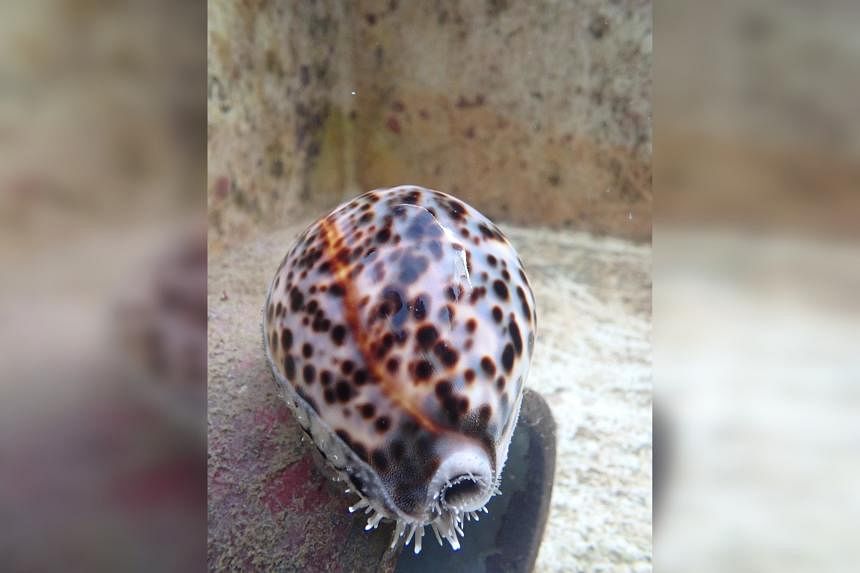
A 7cm long one-year-old tiger cowrie adult. The adult tiger cowrie is one of the largest cowrie species. They are 8cm to 10cm long on average, and can grow up to 15cm.
PHOTO: NUS TROPICAL MARINE SCIENCE INSTITUTE
Ariel Yu
Aug 11, 2024
SINGAPORE – A species of large sea snail native to Singapore waters has been successfully reared to adulthood for the first time by marine biologists from the Tropical Marine Science Institute (TMSI) at the National University of Singapore.
The research team’s rearing of eight tiger cowrie (Cypraea tigris) juveniles has been documented in a recently published study, and the scientists have since managed to rear those eight specimens into adulthood.
Ms Teresa Tay, lead author on this study, said that researchers in previous studies reared the larvae for several weeks but were unable to obtain juveniles.
The tiger cowrie species has been deemed endangered locally due to habitat loss and overharvesting of its shell.
Although it has healthy populations in the Indo-Pacific region, and the molluscs have been found on Singapore’s reefs in the past, it is “now exceedingly rare” to see the tiger cowrie.
A large specimen was seen on one reef off the southern islands in 1988, according to the National Parks Board’s website.
Tiger cowries typically reside in thriving coral reefs. Many of these vital ecosystems have been decimated by destructive practices such as dynamite fishing, which obliterates marine life and corals.
Moreover, rising sea temperatures contribute to coral bleaching, further endangering these fragile habitats and the creatures that depend on them, including the tiger cowrie.
Popular among shell collectors and aquarium hobbyists, the tiger cowrie has been overharvested for its attractive shell and sold in the marine curio market.
The sea snail’s shell is usually egg-shaped, smooth and polished. The shell colour is usually white, yellowish or light blue-greyish, and speckled with spots that can vary from dark brown to black.
Some tiger cowries have a golden yellow mantle, patterned with dark stripes and spots that resemble those of a tiger’s coat.
Its flat underside is white with a slit-like opening in the centre, where its “teeth” can be seen.
The life cycle of the tiger cowrie can be divided into three stages.
Prior to the larval stage, fertilised eggs develop in egg capsules. They then hatch as swimming larvae while their shell volume increases.
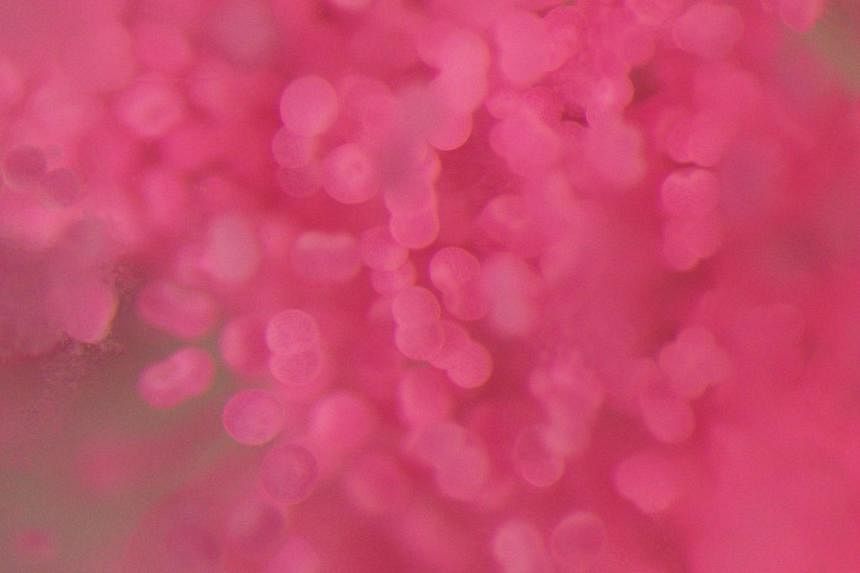
The female tiger cowrie can lay 200 to 300 capsules in one egg mass. Each capsule can contain up to 1000 larvae.
PHOTO: NUS TROPICAL MARINE SCIENCE INSTITUTE
The larvae will eventually settle on the seabed as crawling juveniles. Their shell continues to thicken as they become adults and reach sexual maturity.
Ms Tay said the research team had 25 failed attempts over 10 months before successfully breeding the tiger cowrie.
“From the first batch of tiger cowrie larvae, it took a year to successfully obtain juveniles (from the 26th batch), and then another year for the juveniles to reach adulthood and become capable of reproduction,” she added.
Out of approximately 360 tiger cowrie larvae reared from the 26th batch, eight have survived to adulthood.
The study, which was published in the Molluscan Research journal in July, documented that the tiger cowrie larvae were reared to the juvenile stage, and the research team was able to continue rearing the same batch of larvae to adulthood.
The larvae will eventually settle on the seabed as crawling juveniles. Their shell continues to thicken as they become adults and reach sexual maturity.
Ms Tay said the research team had 25 failed attempts over 10 months before successfully breeding the tiger cowrie.
“From the first batch of tiger cowrie larvae, it took a year to successfully obtain juveniles (from the 26th batch), and then another year for the juveniles to reach adulthood and become capable of reproduction,” she added.
Out of approximately 360 tiger cowrie larvae reared from the 26th batch, eight have survived to adulthood.
The study, which was published in the Molluscan Research journal in July, documented that the tiger cowrie larvae were reared to the juvenile stage, and the research team was able to continue rearing the same batch of larvae to adulthood.
Sighting of endangered bird fledgling confirms first mainland Singapore breeding in over 70 years
One of the main challenges the research team faced was the high mortality rate of tiger cowrie larvae due to algae growth on the shells.
Ms Tay, who joined TMSI in 2013, said: “Often, the algae would engulf the shell, leading to poor development and eventually mortality.”
To tackle this issue, the team attempted to reduce bacteria growth by using finer filtered seawater and adding antibiotics when culturing the tiger cowrie larvae to the juvenile stage, which “drastically reduced algae growth on shells and allowed the larvae to develop further”.
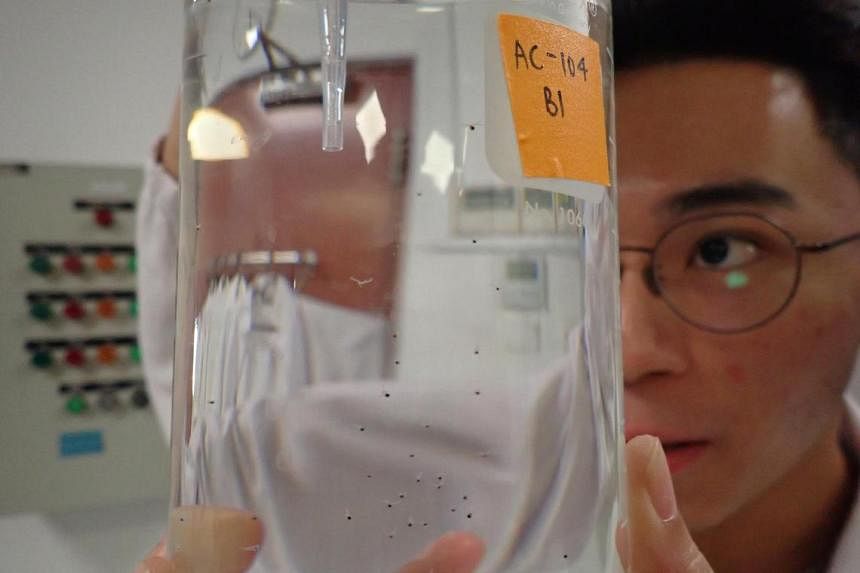
Suitable water quality and diet are key to the successful breeding of tiger cowries by marine biologists in Tropical Marine Science Institute.
PHOTO: NUS TROPICAL MARINE SCIENCE INSTITUTE
Another challenge the team is working to overcome is the high mortality rate of newly settled juveniles during the first month.
“The metamorphosis process (from larvae to juvenile stage) is energy-consuming and we have yet to determine the most suitable diet for young juveniles to thrive in captivity,” said Ms Tay.
The young juveniles currently feed on biofilm – a thin layer of different micro-organisms – and turf algae, which are grown on tiles.
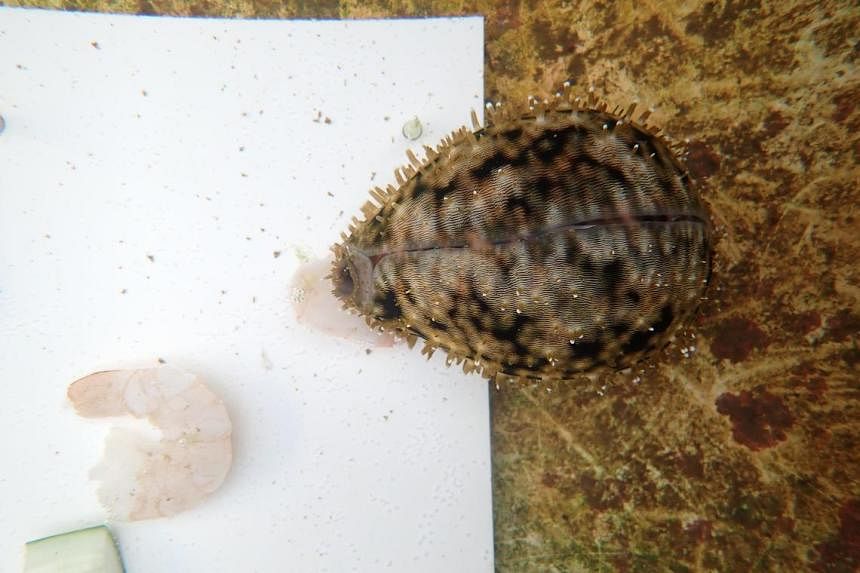
Another challenge the team is working to overcome is the high mortality rate of newly settled juveniles during the first month.
“The metamorphosis process (from larvae to juvenile stage) is energy-consuming and we have yet to determine the most suitable diet for young juveniles to thrive in captivity,” said Ms Tay.
The young juveniles currently feed on biofilm – a thin layer of different micro-organisms – and turf algae, which are grown on tiles.

The adult tiger cowries are fed a variety of food, including prawns and cucumbers, which can enhance their growth and production of eggs and sperm.
PHOTO: NUS TROPICAL MARINE SCIENCE INSTITUTE
In a previous study published in the Royal Society Open Science journal in April 2023, the researchers succeeded in rearing the larvae of only the Arabian cowrie to juveniles, even though they attempted to also rear the tiger cowries to the juvenile stage.
The adult tiger cowrie is one of the largest cowrie species, 8cm to 10cm long on average, and can grow up to 15cm.
The adult Arabian cowrie, also native to Singapore’s waters, is about 8cm long on average, and can grow to be up to 10cm.
Unlike the tiger cowrie, the Arabian cowrie typically has a bluish shell adorned with fine, dotted brown lines, but its patterns vary.
The study published in Royal Society Open Science documented how more than 80 per cent of the tiger cowrie larvae survived the first four days after hatching but kept dying from day five to day 14, due to severe algal growth on their shells, as well as parasite attacks.
As the tiger cowrie is endangered in Singapore, this study seeks to develop farming methods so that the production of cowries can be scaled up for research, conservation and the aquarium trade.
Dr Jani Tanzil, senior research fellow at TMSI and facility director at St John’s Island National Marine Laboratory, said: “Cowries sold in the aquarium trade can come from sustainable, cultured sources now.
“Of course, there might be cost implications – the cost for captive-bred cowries will most likely be higher than for wild-caught stocks.”
She added that this is similar to the cost for anemone fishes, which are now mostly captive-bred in the aquarium trade.
However, Dr Tanzil, who is also a co-principal investigator of the study, said that the cost gap may be reduced with further improvements of mariculture techniques.
In response to the results of the TMSI study, Sunbeam Aquarium – a local wholesale exporter of ornamental freshwater fish, crustaceans, molluscs, soft corals, marine fish and aquatic plants – said it had stopped selling tiger cowries about two years ago but can market the tiger cowrie as captive-bred at a higher price.
“Customers these days are more knowledgeable and environmentally aware.
“Thus, they are more willing to pay for products which reduce the environmental impact,” said a spokesperson for Sunbeam.
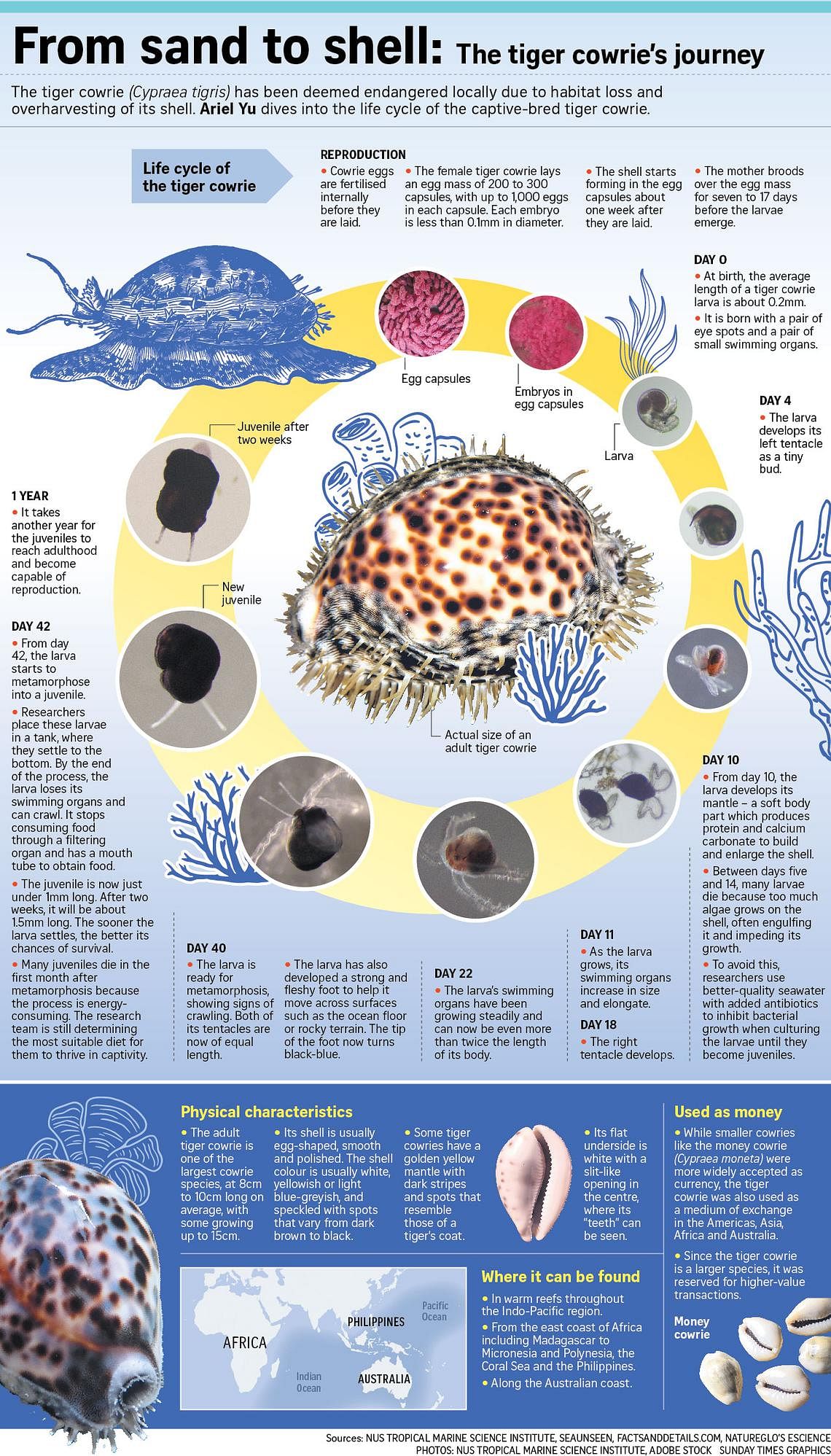
In a previous study published in the Royal Society Open Science journal in April 2023, the researchers succeeded in rearing the larvae of only the Arabian cowrie to juveniles, even though they attempted to also rear the tiger cowries to the juvenile stage.
The adult tiger cowrie is one of the largest cowrie species, 8cm to 10cm long on average, and can grow up to 15cm.
The adult Arabian cowrie, also native to Singapore’s waters, is about 8cm long on average, and can grow to be up to 10cm.
Unlike the tiger cowrie, the Arabian cowrie typically has a bluish shell adorned with fine, dotted brown lines, but its patterns vary.
The study published in Royal Society Open Science documented how more than 80 per cent of the tiger cowrie larvae survived the first four days after hatching but kept dying from day five to day 14, due to severe algal growth on their shells, as well as parasite attacks.
As the tiger cowrie is endangered in Singapore, this study seeks to develop farming methods so that the production of cowries can be scaled up for research, conservation and the aquarium trade.
Dr Jani Tanzil, senior research fellow at TMSI and facility director at St John’s Island National Marine Laboratory, said: “Cowries sold in the aquarium trade can come from sustainable, cultured sources now.
“Of course, there might be cost implications – the cost for captive-bred cowries will most likely be higher than for wild-caught stocks.”
She added that this is similar to the cost for anemone fishes, which are now mostly captive-bred in the aquarium trade.
However, Dr Tanzil, who is also a co-principal investigator of the study, said that the cost gap may be reduced with further improvements of mariculture techniques.
In response to the results of the TMSI study, Sunbeam Aquarium – a local wholesale exporter of ornamental freshwater fish, crustaceans, molluscs, soft corals, marine fish and aquatic plants – said it had stopped selling tiger cowries about two years ago but can market the tiger cowrie as captive-bred at a higher price.
“Customers these days are more knowledgeable and environmentally aware.
“Thus, they are more willing to pay for products which reduce the environmental impact,” said a spokesperson for Sunbeam.

No comments:
Post a Comment